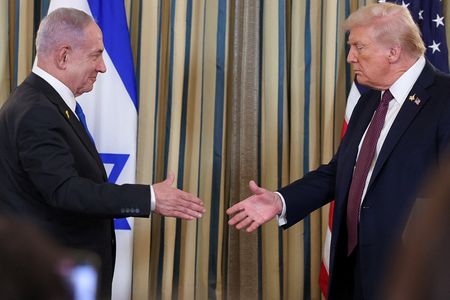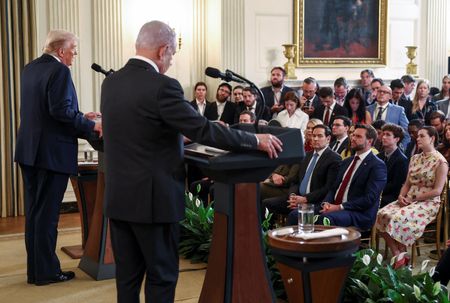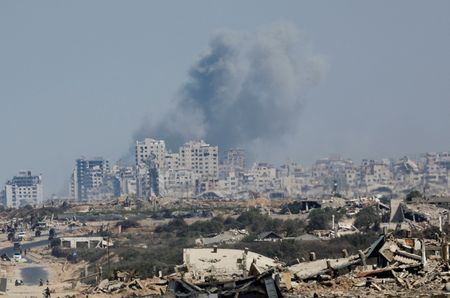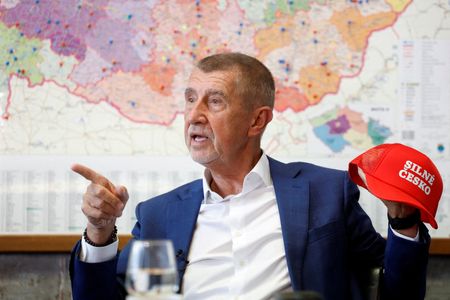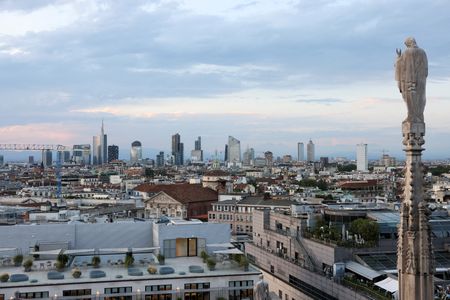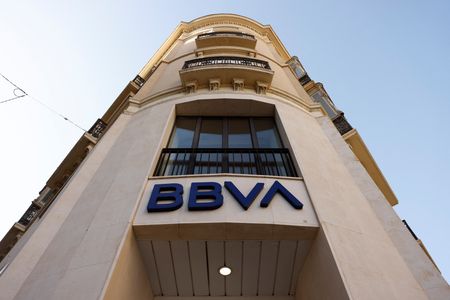By Matt Spetalnick, Trevor Hunnicutt and Nidal al-Mughrabi
WASHINGTON/CAIRO/JERUSALEM (Reuters) -President Donald Trump secured Israeli Prime Minister Benjamin Netanyahu’s backing on Monday for a U.S.-sponsored Gaza peace proposal to end a nearly two-year-old war in the Palestinian enclave, but questions loomed over whether Hamas would accept the plan.
Speaking at a joint White House press conference, Trump said they were “beyond very close” to an elusive peace deal but he warned the Islamist group that Israel would have full U.S. support to take whatever action it deemed necessary if the militants reject what he has offered.
While Netanyahu met Trump for pivotal talks, the White House released a 20-point document that calls for a ceasefire, an exchange of hostages held by Hamas for Palestinian prisoners held by Israel, a staged Israeli withdrawal from Gaza, Hamas disarmament and a transitional government led by an international body.
Trump thanked Netanyahu “for agreeing to the plan and for trusting that if we work together, we can bring an end to the death and destruction that we’ve seen for so many years, decades, even centuries, and begin a new chapter of security, peace and prosperity for the entire region.”
NETANYAHU SAYS PLAN MEETS ISRAEL’S WAR AIMS
Standing next to Trump, Netanyahu responded: “I support your plan to end the war in Gaza, which achieves our war aims.”
“It will bring back to Israel all our hostages, dismantle Hamas’ military capabilities, end its political rule, and ensure that Gaza never again poses a threat to Israel,” he said.
It was clear, however, that Hamas remained the key to whether Trump’s peace proposals get off the ground, and the group’s absence from negotiations so far raised serious questions about the plan’s viability.
In Netanyahu’s fourth White House visit since Trump returned to office in January, the right-wing Israeli leader was looking to shore up his country’s most important relationship after a slew of Western leaders formally embraced Palestinian statehood at the United Nations last week in defiance of the U.S. and Israel.
Trump, who sharply criticized the recognition moves as a prize for Hamas, went into Monday’s meeting seeking Netanyahu’s agreement despite Israel’s misgivings on parts of the plan.
It marked a stepped-up diplomatic effort from the U.S. president, who vowed during the 2024 presidential campaign to quickly bring the conflict to a close and has since repeatedly claimed that a peace deal was near, only for it to fail to materialize.
Without Hamas, that could be the fate of the latest effort as well. The Islamist militant Palestinian group, which triggered the war with its October 7, 2023, attack on Israel, still holds 48 hostages, 20 of them still alive, Israel says.
“Hamas hasn’t yet received the plan officially, nothing beyond media publication,” a Hamas official told Reuters.
Trump ended what was originally billed as a press conference without taking questions, a rare decision for a president who often speaks to reporters off-the-cuff.
Netanyahu, while praising Trump as a friend of Israel, appeared to put some distance between himself and some of the items in Trump’s peace plan, including the reforms being demanded of the internationally recognized Palestinian Authority.
It was not immediately clear whether the Trump administration and Israel had resolved all their differences.
Previous U.S.-backed ceasefire efforts have fallen apart due to a failure to bridge the gap between Israel and Hamas, and Netanyahu has vowed to continue fighting until Hamas is completely dismantled.
ISRAELI ASSAULT HAS LEFT MUCH OF GAZA IN RUINS
Washington presented its peace plan to Arab and Muslim states on the sidelines of the U.N. General Assembly last week, and Trump’s main objective on Monday was to close the remaining gaps with Netanyahu.
Israel has launched one of its biggest offensives of the war this month, with Netanyahu saying he aims to wipe out Hamas in its final redoubts. The war has left much of Gaza in ruins and caused a major humanitarian crisis.
Arriving by limousine, Netanyahu was greeted by Trump outside the White House doors with a handshake, a stark contrast to the Israeli prime minister’s chilly reception when he spoke on Friday before the U.N. General Assembly, where scores of delegates walked out in protest.
The plan, crafted by U.S. special envoy Steve Witkoff and Trump first-term Middle East adviser, Jared Kushner, envisions a ceasefire followed by the release within 72 hours of all remaining hostages held by Hamas in exchange for hundreds of Palestinian prisoners held by Israel, and the gradual withdrawal of Israeli forces from Gaza.
The plan outlines a vague path toward Palestinian statehood once Gaza’s redevelopment is well under way and the Palestinian Authority undertakes reforms, but does not provide details or a timeframe.
The question of eventual Palestinian statehood, which Netanyahu has vowed never to let happen, was among the main sticking points to Netanyahu’s acceptance of Trump’s initiative, according to a source close to the talks.
Under the plan, the U.S. would work with Arab partners and other international parties to develop a temporary stabilization force to oversee security, the source said. Gaza would be governed without Hamas involvement and initially only a limited role for a Palestinian Authority “representative.” Netanyahu has said the PA must not control the territory despite its having signed the 1993 Oslo Accords with Israel.
Hamas-led fighters killed around 1,200 people and captured 251 hostages in the attack on Israel, according to Israeli tallies. More than 66,000 Palestinians have since been killed in Israel’s assault, according to Gaza health authorities.
(Reporting by Matt Spetalnick, Steve Holland and Trevor Hunnicutt in Washington, Howard Goller in New York, Nidal al-Mughrabi in Cairo, Alexander Cornwell in Jerusalem; Writing by Matt Spetalnick; Editing by Peter Graff, Jon Boyle, Aidan Lewis, Nia Williams and Howard Goller)

